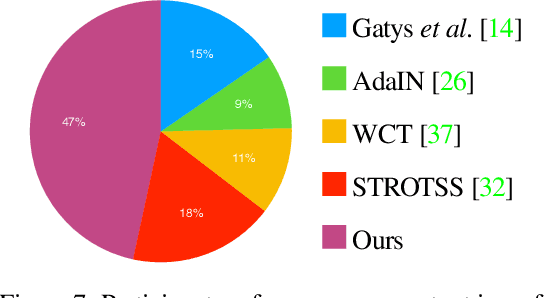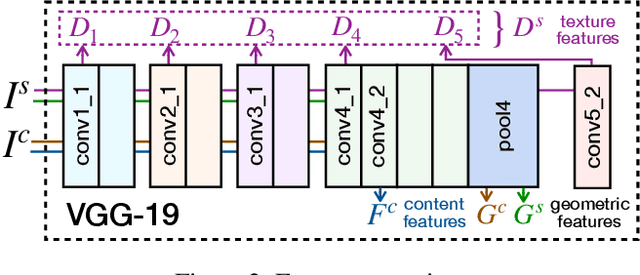Xuan-Yi Li
Geometric Style Transfer
Jul 10, 2020



Abstract:Neural style transfer (NST), where an input image is rendered in the style of another image, has been a topic of considerable progress in recent years. Research over that time has been dominated by transferring aspects of color and texture, yet these factors are only one component of style. Other factors of style include composition, the projection system used, and the way in which artists warp and bend objects. Our contribution is to introduce a neural architecture that supports transfer of geometric style. Unlike recent work in this area, we are unique in being general in that we are not restricted by semantic content. This new architecture runs prior to a network that transfers texture style, enabling us to transfer texture to a warped image. This form of network supports a second novelty: we extend the NST input paradigm. Users can input content/style pair as is common, or they can chose to input a content/texture-style/geometry-style triple. This three image input paradigm divides style into two parts and so provides significantly greater versatility to the output we can produce. We provide user studies that show the quality of our output, and quantify the importance of geometric style transfer to style recognition by humans.
LSANet: Feature Learning on Point Sets by Local Spatial Attention
May 14, 2019



Abstract:Directly learning features from the point cloud has become an active research direction in 3D understanding. Existing learning-based methods usually construct local regions from the point cloud and extract the corresponding features using shared Multi-Layer Perceptron (MLP) and max pooling. However, most of these processes do not adequately take the spatial distribution of the point cloud into account, limiting the ability to perceive fine-grained patterns. We design a novel Local Spatial Attention (LSA) module to adaptively generate attention maps according to the spatial distribution of local regions. The feature learning process which integrates with these attention maps can effectively capture the local geometric structure. We further propose the Spatial Feature Extractor (SFE), which constructs a branch architecture, to aggregate the spatial information with associated features in each layer of the network better.The experiments show that our network, named LSANet, can achieve on par or better performance than the state-of-the-art methods when evaluating on the challenging benchmark datasets. The source code is available at https://github.com/LinZhuoChen/LSANet.
 Add to Chrome
Add to Chrome Add to Firefox
Add to Firefox Add to Edge
Add to Edge